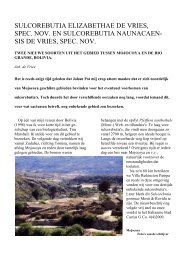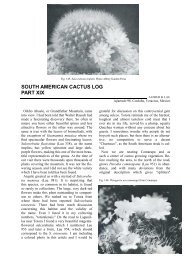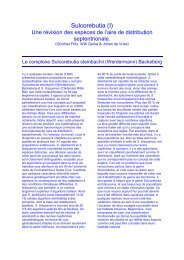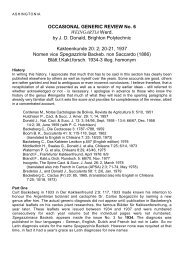Sulcorebutia, food for taxonomists?
Sulcorebutia, food for taxonomists?
Sulcorebutia, food for taxonomists?
You also want an ePaper? Increase the reach of your titles
YUMPU automatically turns print PDFs into web optimized ePapers that Google loves.
minuscula? Albert Hofman (personal statement) assumes that the first description of the<br />
species fidaiana (fidana Hunt 2006) has to be taken as a first description of the genus also.<br />
Well, I have seen quite some cacti with this label, but with many of them I really had doubts<br />
that these were the plants meant by Backeberg. Are experts more flexible than me? Or is there<br />
insufficient quality of reference data (incomplete, inaccurate), as a result of which<br />
classifications are also unreliable.<br />
Another genus Spegazzinia already existed at the time. There<strong>for</strong>e Werdermann changed the<br />
name of the genus into Weingartia (1937) without supplying extra in<strong>for</strong>mation. Later on<br />
Echinocactus cummingii, which had been described already in 1849, was also classified in<br />
this genus. The result of this remarkable sequence of events was nevertheless correct. Not<br />
only was the genus Weingartia poorly defined by the summary description of Backeberg, the<br />
plant description also was not clear, as the name had been used twice, <strong>for</strong> completely different<br />
plants, which had died long ago.<br />
Boom (1962) dedicated a very worthwhile article to the correct name of the plant. He ended<br />
his account with the remark “Look at what the consequences may be if the international Rules<br />
<strong>for</strong> Botanical Nomenclature are not employed in the right way; it is definitely necessary, that<br />
everybody, who is occupied with the taxonomy of cacti (and of course of all other plants)<br />
acquaint themselves with the proper use of these rules. Especially in the case of cacti much<br />
incompetent work has been done in this area.“ Then a list of names followed. In case of<br />
ambiguous names was added „quoad descr.“.<br />
Echinocactus cumingii Salm Cat. Hort. Dyck. 1849, 174 (1850) non Hopffer, Allg. Gartenz.<br />
11, 225 (1843)<br />
Lobivia cumingii (Hopff.) Br. & R., The Cact., 5, (1922). quoad descr.<br />
Oroya cumingii Kreuz., Syst., 1935<br />
Spegazzinia cumingii (Hopff.) Back., Kakt. ABC, 298 (1935), quoad descr.<br />
Weingartia cumingii (Hopff.) Werd. ex van Oosten in Succ. 21, 129 (1939), quoad descr.<br />
Weingartia neocumingii Back. in Kakt. u.a. Sukk., 1, 2 (1950).<br />
Fig. 6 Weingartia neumanniana<br />
Gymnantha cumingii (Hopff.) Ito, Expl. Diagr. 53, 1957, quoad descr.<br />
Gymnocalycium neocumingii (Back.) Hutch. in Cact. & Succ. J. (U.S.), 29, 1957<br />
Gymnocalycium cumingii (Br. & R.) Hutch. in Nat. Cact. & Succ J., 14, 1959.<br />
I can imagine that not only the interested amateur will be lost here, the professional<br />
taxonomist will also perhaps do a double-take. How could the name of a species be connected<br />
to different genera so often in only 35 years? Searching <strong>for</strong> explanations, one is reminded of<br />
the speed with which Jaap solved taxonomical problems.<br />
Personally I would guess that the poor quality of in<strong>for</strong>mation is the cause of this chaos.<br />
<strong>Sulcorebutia</strong><br />
Backeberg defined the genus <strong>Sulcorebutia</strong> (1951). Here is an attempt to interpret the Latin<br />
text: „Plants caespitose, with rather small offsets, ribs tuberculous; tubercles lobivoid,<br />
axeshaped (!), with crack (!); flower funnel <strong>for</strong>m, originating from the circle round expanded<br />
crack, with the colour of the morning sun, with scales, hairless (!) fruit still unknown –<br />
Bolivia, near Colomi (Cochabamba) in an altitude of 3400m (Cardenas). Typus: Rebutia<br />
Steinbachii Werd.”<br />
The characters followed by “(!)” will have been the main criteria. It is nice to conclude, that<br />
this text differs from the one in “Die Cactaceae” (1959).<br />
Werdermann described the colour of the flower to be red, Backeberg mentioned “the colour of<br />
the morning sun” like the one of Rebutia violaciflora. (Fig. 7) Previously I had heard the<br />
explanation, that some <strong>taxonomists</strong> were rather flexible in their interpretation of the colour<br />
red. Later on Pip Smart told me, that Martin Cárdenas from Cochabamba had looked <strong>for</strong> years







